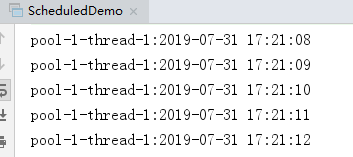java并发编程学习之线程池-预定义线程池(四)
系统预定了几个线程池,不过建议手动创建,以防止错误创建消耗资源,比如创建太多线程或者OOM
FixedThreadPool
固定线程数量,无界队列
public static ExecutorService newFixedThreadPool(int nThreads) {
return new ThreadPoolExecutor(nThreads, nThreads,
0L, TimeUnit.MILLISECONDS,
new LinkedBlockingQueue<Runnable>());
}
SingleThreadExecutor
固定线程数量,数量为1,无界队列,会按顺序执行
public static ExecutorService newSingleThreadExecutor() {
return new FinalizableDelegatedExecutorService
(new ThreadPoolExecutor(1, 1,
0L, TimeUnit.MILLISECONDS,
new LinkedBlockingQueue<Runnable>()));
}
CachedThreadPool
不限制线程数量,使用SynchronousQueue队列,使用于短任务
public static ExecutorService newCachedThreadPool() {
return new ThreadPoolExecutor(0, Integer.MAX_VALUE,
60L, TimeUnit.SECONDS,
new SynchronousQueue<Runnable>());
}
WorkStealingPool
基于ForkJoinPool
public static ExecutorService newWorkStealingPool(int parallelism) {
return new ForkJoinPool
(parallelism,
ForkJoinPool.defaultForkJoinWorkerThreadFactory,
null, true);
}
ScheduledThreadPoolExecutor
用于周期性执行任务
public static ScheduledExecutorService newSingleThreadScheduledExecutor() {
return new DelegatedScheduledExecutorService
(new ScheduledThreadPoolExecutor(1));
}
示例
public class ScheduledDemo {
static class Thread1 implements Runnable {
@Override
public void run() {
SimpleDateFormat formater = new SimpleDateFormat(
"yyyy-MM-dd HH:mm:ss");
System.out.println(Thread.currentThread().getName() + ":" + formater.format(new Date()));
}
}
public static void main(String[] args) {
ScheduledThreadPoolExecutor schedule
= new ScheduledThreadPoolExecutor(1);
//第一个是Runnable,第二个是第一次开始的时间,第三个是周期时间,第四个是时间单位
schedule.scheduleAtFixedRate(new Thread1(),1000,1000, TimeUnit.MILLISECONDS);
}
}
运行结果如下:

正文到此结束
热门推荐
相关文章
Loading...











![[HBLOG]公众号](https://www.liuhaihua.cn/img/qrcode_gzh.jpg)

